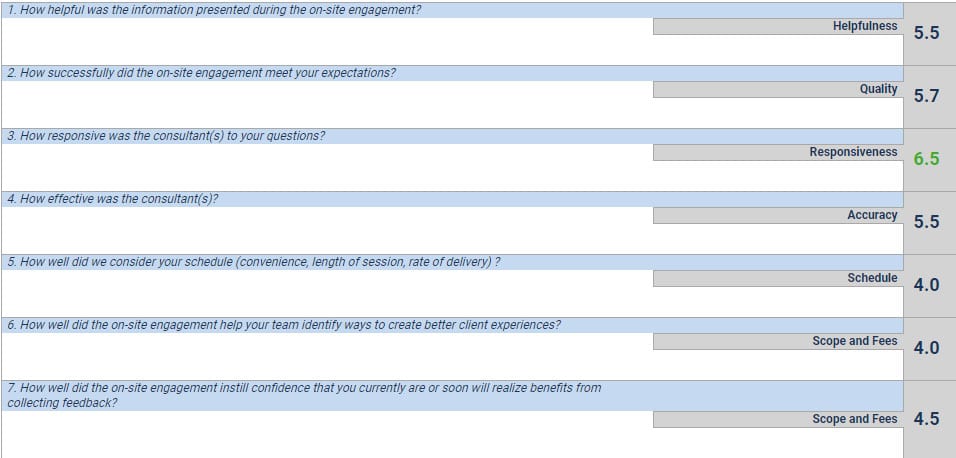"You guys are great. The slowdowns are all on my end."
"You provided us exactly what we needed."
"Mary is great to work with and always responds promptly."
It’s a funny thing about feedback. So many of us associate feedback with hearing what we’ve done wrong or how we missed the mark. When the reality is, when you ask your clients how your firm is doing, nearly 80 percent of the time, their comments will be very positive just like the ones above taken from actual feedback received. And, when you are trying to gain traction with your client experience management program (CXM), positive reinforcement is exactly what you want to provide your team. And that means asking your clients for feedback.
Getting Started
Whether or not your firm is ready to implement an ongoing feedback program with your clients, consider doing a Baseline Client Perception Analysis. This need not be an expensive (or cumbersome) process. Client Savvy’s Baseline Client Perception Analysis lets you ask your client base for feedback in a formalized way. The information you collect can then be the foundation you use for considering what intentional changes you want to make to enhance your clients’ experience working with your firm. Instead of guessing what your clients are thinking (and what they value), you’ll have qualitative and quantitative insights.
The steps to completing a baseline analysis with Client Savvy are straightforward:
- Kick-off call with our team
- Identify the list of clients you would like to include
- Work with our experts to create a list of questions that are proven to be comfortable for your clients to respond to (and provide you with the data you need)
- Work with our experts to create survey messaging you can send to let your clients know what and why you are asking them for their feedback
- Respond to the feedback you receive (we’ve got a list of best practices to share with you)
Results
The results of the baseline analysis will include:
- A summary graph showing how your clients (overall) perceive you meet their expectations in six categories (see Figure 1)
- A detailed response from each person responding to your request for feedback (see Figure 2)
- A complete list of comments including their response to the question: How likely are you to refer our firm to a colleague?
Figure 1: This Summary Graph shows all the scores reported as a result of Baseline Analysis. Note the numbers alongside the seven different categories show how many responses are included for that category in the Summary Report.
Figure 2: This graphic shows the detailed response from one individual responding to your request for feedback. Note that within each question is the opportunity for the client to provide not only a quantitative score but also a qualitative comment.
How to use the information
Once you’ve completed your Baseline Client Perception Analysis, Client Savvy will run through the results with your team. We’ll answer your questions, point out comments and/or responses you may want to explore further and help you get started on your next steps.
With specific feedback and insight, you and your team can close any service delivery gaps that exist. You can make changes to enhance your clients’ experience. Client Empathy Mapping is a dynamic (and fun) exercise. It creates excitement around your team’s enhanced CX thinking.
Client Empathy Maps can be used for a variety of purposes. At their core, they give your team a deeper understanding of your clients. They allow you to design (or tweak) your processes based on that understanding. With the results of your Baseline Client Perception Analysis, you might choose to take a closer look at the experience your clients might be having in a specific aspect of your service delivery. You can do this by digging into any category that has a lower score than others. In Figure 1, that might be looking at "Responsiveness." Looking at one individual’s response (Figure 2), might indicate "Responsiveness" is not an issue. However, the summary of scores in this category indicates there might be an opportunity to close an experience gap.
How Client Empathy Mapping Works
Client Empathy Mapping is a powerful tool. It walks your team through a process where you consider what your clients are thinking, feeling, saying, or doing as they work with your firm. In this case, you are looking to close the experience gap as it relates to your clients’ overall perception of your firm’s responsiveness. Since most interaction occurs as you work with them on a particular project or matter, taking a look at what they are experiencing emotionally during that process makes sense.
Figure 3 This is an example of the questions you and your team will ask as you go through the process. With the exception of "Actions," which are actions you and your firm might take in response to how your clients are feeling, each of these provides your team with the chance to look at the situation through the clients' eyes incorporating what they already know about the client.
Client Scenario
With this in mind, let’s look at a specific scenario with responsiveness as the focus.
You just had a meeting with your client at a pivotal point in the project. There are deliverables to be provided by your team. The client wants this information so they can decide how they will move forward. Before leaving the meeting, you agreed to send information to them in two weeks. It is now three days before the deadline. You’re not late in delivering on what was promised. However, let’s look at what your client "might" be thinking and feeling.
How might your clients answer the questions in Figure 3?
Questions:
I wonder what (firm name) will share with us? I wonder if they will get us the information on time? Or, maybe even a bit early? Our timeline is important to us.
Needs:
If you know your client is feeling a bit anxious (and you probably do), they might "need" you to shoot them an email about halfway through the timeline. Let them know that you're on schedule and you’ll have some information for them when promised.
Thinking:
If your client tends to be anxious about deadlines, they might be thinking, “What will we do if (your firm) hits a snag and is delayed? How will we manage that and keep things on track?”
Feeling:
Based on this scenario, your client might be feeling stressed. The importance of the information you are getting ready to provide them, and the uncertainty of what they will need to do next, is weighing on them.
Saying:
Your contact may be contacting others around them expressing anxiety and concern that your team will deliver as promised. While they may be trying to get reassurance, questions like this can plant a seed of doubt in the minds of others.
Doing:
Your client contact might shoot you over an email saying, “How are things going?” or “Just checking in…” Unless you recognize their anxiety, your team may think, “Did they forget the timeline? We’re not late. We’ll get it to them as promised.”
Actions:
Your team might send the client a preemptive email. “I know you are anxiously awaiting the results of this work we’re doing for you. Things are going well and a) here is something preliminary for you to think about or b) it looks like there will be no real changes in the original plans. We’ll have the final product to you on time."
Take the next step
Client Experience Management is not some big thing your firm needs to do. Your clients already have an experience every day with your brand. Understanding if there is a gap between what you want them to feel and how they feel is the first step. Take steps to understand your client’s perception of those interactions. Then, engage your team in closing the experience gap benefits everyone.
Let us help you get started. Email us at Answers@clientsavvy.com or give us call us at 1-866-433-7322.
A 15-minute phone call with our client experience experts will give you insight into the next steps that make sense for your firm.








